

Future - Why the 'post-natural' age could be strange and beautiful. At 4913 Penn Ave, Pittsburgh, there is an unusual institution.
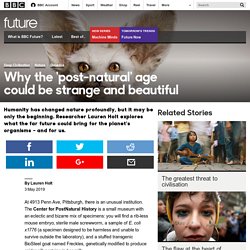
The Center for PostNatural History is a small museum with an eclectic and bizarre mix of specimens: you will find a rib-less mouse embryo, sterile male screwworm, a sample of E. coli x1776 (a specimen designed to be harmless and unable to survive outside the laboratory), and a stuffed transgenic BioSteel goat named Freckles, genetically modified to produce spider silk proteins in her milk. The museum’s subject, post-naturalism, is the study of the origins, habitats, and evolution of organisms that have been intentionally and heritably altered with genetic engineering, and the influence of human culture and biotechnology on evolution. Its tagline: “That was then. This is now”, complements its logo, an evolutionary tree with an arrow joining two distinct branches. Visitors are encouraged to consider that each specimen has a natural, evolutionary history, as well as a post-natural, cultural one. What America will look like in 2040: Older, less white, less religious - Axios.
When Futurism Led to Fascism—and Why It Could Happen Again. 401(k)s, abortion, youth football: 15 things we do now that will be considered unthinkable in 50 years. Some 50 years ago, in 1964, 42 percent of Americans smoked cigarettes.

Smoking in bars and offices was normal and cigarettes were given to soldiers as part of military rations. Half of American physicians smoked. Ads for cigarettes bombarded the American public. That year, the surgeon general released a report outlining the health risks of smoking. Two years later, only 40 percent of Americans said that they believed smoking was a major cause of cancer. Today, we know that smoking is bad for our health. The Future Agency - The Verge - Pocket.
In the Dubai of 2050, the world looks both instantly familiar and utterly strange.

Here, urban planning is driven by an omniscient AI installed at the top of a skyscraper; your smart bathroom mirror tracks your physical health; and you interface with the government through a personalized “genie,” a hologram in the form of a virtual Emirati gentleman in traditional garb. All of these future products are skinned in a particular visual aesthetic of friendly white-on-black animated icons like a minimalist, sentient version of Apple’s iOS. This uncanny scene was on display at the United Arab Emirates’ second annual Government Summit, hosted in Dubai in February 2014.
The World Wide Web Turns 30. Where Does It Go From Here? What Scientists and City Planners Can Learn from Sci-Fi. In Kim Stanley Robinson’s 2017 science-fiction novel New York 2140, the city of the future has become a vertical super-Venice, after being flooded by rising seas caused by global warming melting the Arctic ice caps.1 While the lower stories of many of Manhattan’s skyscrapers have been overtaken by the sea, residents continue to live in those above, accessing them via boathouses and pontoons.

Bill Gates: How we’ll invent the future. I was honored when MIT Technology Review invited me to be the first guest curator of its 10 Breakthrough Technologies.

Narrowing down the list was difficult. I wanted to choose things that not only will create headlines in 2019 but captured this moment in technological history—which got me thinking about how innovation has evolved over time. Future - Are we on the road to civilisation collapse? Great civilisations are not murdered.
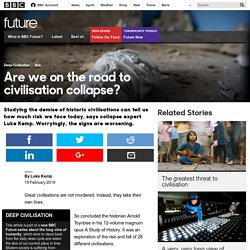
Instead, they take their own lives. This article is part of a new BBC Future series about the long view of humanity, which aims to stand back from the daily news cycle and widen the lens of our current place in time. Florida is drowning. Condos are still being built. Can't humans see the writing on the wall? I stood behind a worn shopping center outside of Crystal Springs, Florida, looking for the refuge where a hundred manatees were gathered for winter.
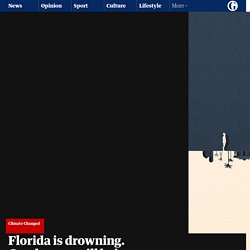
I found them clustered in the emerald-colored spring, trying to enjoy a wedge of sunlight and avoid the hordes of people like me, boxing them in on kayaks and tour boats, leering over wooden decks. The nearby canals were lined with expensive homes and docks with jetskis. One manatee breached the water for a breath, and I could see the propeller scar on its back. 2018 was the second deadliest year on record for manatees. Like many of our coastal species, they’re vulnerable to habitat loss and warming seas, which are more hospitable to algal blooms and red tide.
Studies show that humans don’t respond well to abstract projections. Humans tend to respond to immediate threats and financial consequences – and coastal real estate, especially in Florida, may be on the cusp of delivering that harsh wake-up call. The Next Wave of ‘Unicorn’ Start-Ups. The World Might Actually Run Out of People.
The Meaning of Life in a World without Work - The Guardian - Pocket. Most jobs that exist today might disappear within decades.

As artificial intelligence outperforms humans in more and more tasks, it will replace humans in more and more jobs. Many new professions are likely to appear: virtual-world designers, for example. But such professions will probably require more creativity and flexibility, and it is unclear whether 40-year-old unemployed taxi drivers or insurance agents will be able to reinvent themselves as virtual-world designers (try to imagine a virtual world created by an insurance agent!). And even if the ex-insurance agent somehow makes the transition into a virtual-world designer, the pace of progress is such that within another decade he might have to reinvent himself yet again.
The crucial problem isn’t creating new jobs. Are you a robot? Masayoshi Son wants Arm’s blueprints to power all tech - Armed with a crystal ball. Why SoftBank's Masayoshi Son is Silicon Valley's power broker. A 2010 talk by SoftBank CEO Masayoshi Son offers a glimpse of his vision of the distant future. Many people in the tech industry struggle to understand SoftBank.
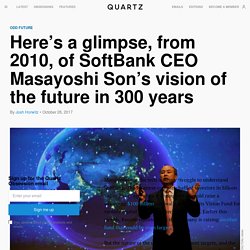
The Japanese company baffled investors in Silicon Valley a year ago when it announced it would raise a whopping $100 billion (paywall) to launch its Vision Fund for venture capital investing in tech companies. Earlier this month, Recode reported that the company is raising another fund that could be even larger. 2038 Podcast: What the World Will Look Like in 20 Years. We Asked 105 Experts What Gives Them Hope About the Future. The majority of participants referenced human ingenuity and collective action as sources of hope and inspiration.
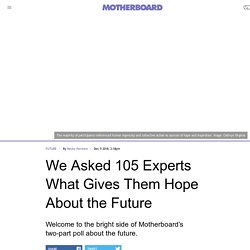
Image: Cathryn Virginia The expression “may you live in interesting times” can be interpreted as both a blessing and a curse, which makes it seem especially resonant these days. As humans stare down multiple threats to our civilization—biased algorithms, climate change, political extremism—it is easy to feel overwhelmed by all the “interesting” developments taking place around us. Future-internet-of-things. The Future Agency - The Verge - Pocket. In the Dubai of 2050, the world looks both instantly familiar and utterly strange. Here, urban planning is driven by an omniscient AI installed at the top of a skyscraper; your smart bathroom mirror tracks your physical health; and you interface with the government through a personalized “genie,” a hologram in the form of a virtual Emirati gentleman in traditional garb. All of these future products are skinned in a particular visual aesthetic of friendly white-on-black animated icons like a minimalist, sentient version of Apple’s iOS.
This uncanny scene was on display at the United Arab Emirates’ second annual Government Summit, hosted in Dubai in February 2014. What Happens Next. The Future of Home: How technology will reshape our home lives—and our privacy.